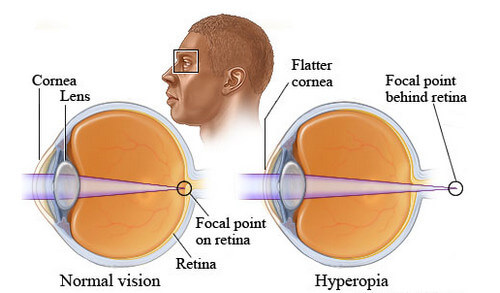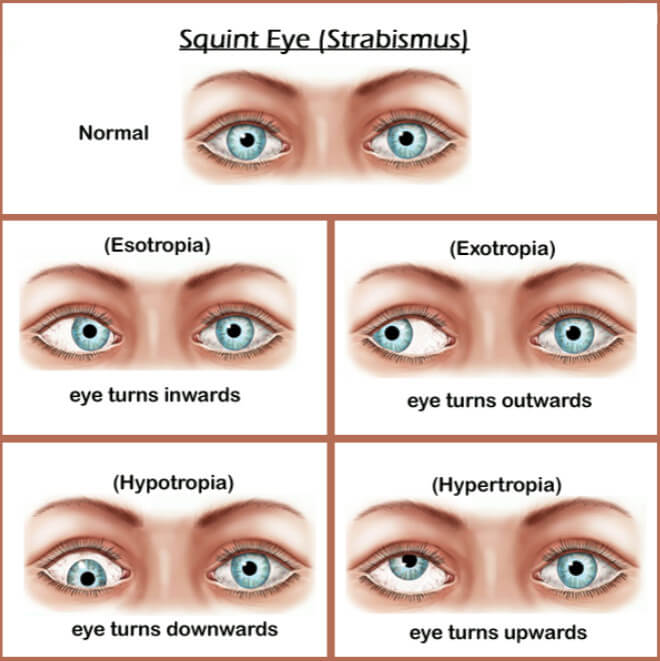Hyperopia
Hyperopia Definition
Hyperopia is derived from the words hyper- (beyond) and the Greek word ōps or eye.
This means that a person with this condition would be reporting ability to see objects clearly at a distance compared to seeing them at close proximity. Other terms to describe hyperopia are farsightedness or long-sightedness [9], which are the layman’s term, and hypermetropia [1].

Picture 1: Normal vision vs Hyperopia
Image Source: wikispaces.com
Hyperopia Pronunciation
Hyperopia is pronounced as hahy-per-oh-pee-uh [12].
Hyperopia (Hypermetropia) Description
Hyperopia is a vision condition that is considered to be a refractive error in seeing objects. The ability to see objects at far distance is the most conducive method for persons having this problem because of short eyeballs or less curvature of the cornea. With these things in consideration, it is very hard to focus on objects that are near.
Normally, when light enters the eye and reaches the retina upfront, we are able to see things clearly. In hyperopia, the light reaches the center of the retina posteriorly or behind it causing the person to see objects more clearer when in far distance [1].

Photo 2: What person sees when they have hyperopia.
Image Source: http://lasikinistanbul.com
The other types of vision problems include myopia (nearsightedness) and presbyopia (farsightedness due to aging).
Types of Hyperopia
In order to determine what type of hyperopia you have, the doctor will perform several tests to assess the extent of severity of farsightedness, accomodation ability of the eye, the reason and clinical presentation of the problem. There are three types of hyperopia:
1. Simple
Cause – irregular shape of the eye and lens position.
Treatment – prescription glasses or contact lenses
2. Functional
Cause – the muscles of the eye are unable to move to focus the eye in seeing.
Treatment – may need further corrective surgeries
3. Pathological
Cause – due to injuries or diseases that affects the eye like cataracts, and anomalous eye development while growing up [10].
Treatment – focus treatment is required to address the clinical problem. For severe cases, hospitalization and surgery may be recommended.
Latent
a type of hyperopia that is not detected until a special examination is performed to uncover the symptoms of farsightedness. The procedure cycloplegic refraction is made by the doctor by instilling cyclopegic drugs (drugs that temporarily paralyzes the eye muscles like atropine) into the eye causing the muscles of accomodation to rest and not perform its ability to focus [11].
Hyperopia Causes
We can pinpoint the causes of hyperopia in two instances:
- Anatomical structure of the eyes, i.e., having shorter eyeballs and a flat cornea leads to a blurry vision of objects within reach.
- Genetics – if parents have been treated for hyperopia overtime, it is a likelihood that children may have also the same visual problem.
It is a misconception that this condition only affects older persons due to ageing. Children can also have hyperopia. As a matter of fact, hyperopia can start in the younger years. This is evidently not noticed at this time because children’s vision can adjust normally because they have very flexible lens.
At around 9 years old, when the normal growth and development process of the eyes stops, this condition can be detected because the lens can no longer adjust losing its ability to focus closely [4].
Hyperopia (Hypermetropia) Symptoms
- The following are common complaints of persons with hyperopia:
- Blurring of vision
- Eye strain characterized by headache, blurred vision, pain surrounding the eyes, and seeing double. This is medically termed as asthenopia.
- Strabismus is manifested as crossed eyes wherein eyes are misaligned and cannot look at the object unanimously.

Picture 3: Different types of strabismus.
Image Source: blogspot.com
- Problem in focusing caused by excess strain in the eyes secondary to overfatigue or too much work. The medical term for this is accommodative dysfunction [3].
- Amblyopia is often called the weak or lazy eye [5]. This condition affects only one eye where in there is decreased vision. This is most common among children.
- Headache
In school-aged children, hyperopia is considered if the child is performing less in school as evidenced by poor grades [7].
Hyperopia Complications
If hyperopia is not corrected or treated accordingly, certain setbacks can arise. For adults, disruption in activities of daily living may be affected because of the inability to see things clearly. One’s safety is also in danger specially if the person is driving, operating machinery or hazardous equipment [6].
In children, learning difficulties and poor academic performance can result from hyperopia [7].
Hyperopia Diagnosis
There is only one way to find out if you have farsightedness or hyperopia. A visit to an eye specialty doctor will determine the degree and extent of your farsightedness. The doctor will be performing a series of tests to examine the structure of the eye and the vision problem.
It is recommended for adults to have a baseline eye examination when you reach 40 years old [6]. Afterwards, medical visits to your opthalmologist can be done on the following suggested intervals [6]:
- 40-54 years – every 2 to 4 years
- 55-65 years – every one – 3 years
- 65 years and above – every one – 2 years
Hyperopia Treatment
Once diagnosed with hyperopia, the doctor would be prescribing the person to wear corrective lenses or a more permanent treatment, which is refractive surgery. Either way, the goal of these treatments is to focus the light that enters the eyes on the retina.
Glasses or Lenses
To correct hyperopia, the lenses can help in preventing the reduced curvature of the cornea or the shortness of the eyeball [8]. There are many kinds of glasses and lenses that will suit your lifestyle. It is always best to consult your eye doctor on the advantages and disadvantages of using glasses and contact lenses.
Surgeries to correct Refractive error
Before deciding to have surgery, it is very important to know the benefits, what’s going to happen during the procedure, and the complications that can happen afterwards. These procedures are performed under sterile technique and is mostly an out-patient basis.
In general, refractive surgeries are most often used in problems of nearsightedness or myopia. The following procedures are indicated to treat hyperopia:
- Laser-assisted subepithelial keratectomy (LASEK) – The surgeon will be creating a flap or cover from the cornea’s epithelium then lifts it. A laser beam, which is called excimer beam, will be focused onto the cornea to correct its outer layers and help deepen the curvature. The epithelium is then replaced back to its new cornea [8].
- Laser-assisted in-situ keratomileusis (LASIK) – The surgeon will still be creating a cover but will no longer lift it from the cornea. The laser is then positioned to focus to the center of the cornea and will remove the layers to deepen the curvature. The cover is then put back in place.
- Photorefractive keratectomy (PRK) – it’s just like the LASEK surgery, but the surgeon no longer replaces the epithelium back after the laser beam application. The area where the original epithelium was removed, will be allowed to regenerate naturally.

Picture 4: The eye after LASIK surgery.
Image Source: wikispaces.com
For the PRK and LASEK procedures, a bandage contact lens will be placed afterwards to facilitate healing.
Possible complications that can happen after eye surgical procedures would include:
- Pain – although this an expected effect after surgery, and your doctor will be prescribing pain relievers to help alleviate the pain, persistent pain on the affected eye should be reported to the doctor immediately.
- Infection – this is characterized by swelling, irritation, presence of pus or excessive secretions from the eye, pain, and even accompanied by fever. Report to your doctor if you have these symptoms.
- Dry eye
- Seeing halo around lights
- Blindness, although can happen rarely
- Over- or under correction of the primary complaint
References:
- Optometric Clinical Practice Guideline Care of the Patient with Hyperopia – http://www.aoa.org/documents/optometrists/CPG-16.pdf
- American Optometric Association: Hyperopia FAQs – http://www.aoa.org/patients-and-public/eye-and-vision-problems/glossary-of-eye-and-vision-conditions/hyperopia/hyperopia-faqs?sso=y
- EyeCare Plus: Accomodative Dysfunction – http://www.eyecareplus.com.au/doc/orange/13-Accomodative-Dysfunction.pdf
- Hyperopia (Farsightedness) and You – http://www.myeyes.com/hyperopia/hyperopia-causes.shtml
- Mayo Clinic: Lazy eye (amblyopia) – http://www.mayoclinic.org/diseases-conditions/lazy-eye/home/ovc-20201878
- Mayo Clinic: Farsightedness – http://www.mayoclinic.org/diseases-conditions/farsightedness/basics/symptoms/con-20027486
- Vision Problems of School Children http://www.allaboutvision.com/parents/schoolage.html
- Mayo Clinic: Treatment of Hyperopia – http://www.mayoclinic.org/diseases-conditions/farsightedness/basics/treatment/con-20027486
- NHS Choices: Long-sightedness – http://www.nhs.uk/Conditions/Long-sightedness/Pages/Complications.aspx
- American Academy of Opthalmologiy: EyeWiki : Hyperopia http://eyewiki.aao.org/Hyperopia
- Dr. Bishops and Associates: Latent Hyperopia http://www.drbishop.com/view/article_273.3conx
- Hyperopia pronunciation http://www.dictionary.com/browse/hyperopia
Published by Dr. Raj MD under Diseases and Conditions.
Article was last reviewed on August 6th, 2018.

